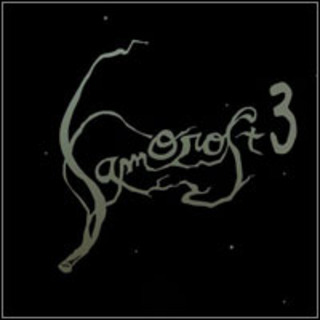INTRO:
Samorost is the game that got Amanita Design noticed in the indie scene, mostly because of its bizarre aesthetics and its freely playable status. The priced sequel apparently did okay enough for Amanita Design to eventually establish itself as a viable company.
With such history, it is not a surprise that they would make a sequel again. This sequel will benefit greatly from the lessons and skills that Amanita Design’s people have learned over the years. On the other hand, they have also not kept up with the latest designs that make adventure games bearable and convenient to play.
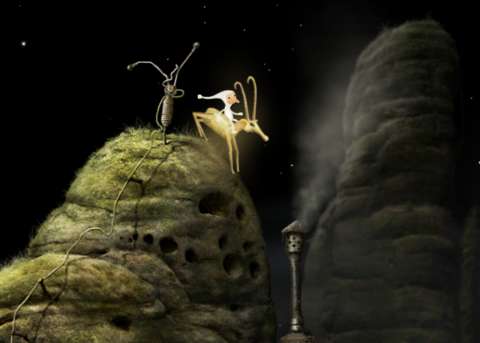
PREMISE:
Like the previous games, the game is set in a fictitiously absurd universe where breathable air is everywhere, even out in space. Gravity is present, but works in ways that are so convenient that Isaac Newton would shake his head in amused disbelief. That said, there are islands that are floating about in space, sometimes with smaller celestial bodies orbiting them.
The game begins with the fish-shaped island that the protagonist of the series lives on. The protagonist is presumably the eponymous Samorost, as implied by the developers in some of their statements. He is still a diminutive person, clad in a white pajama (presumably that is a suit and not a part of him). He still lives in a tower, and his dog is still around.
However, there are notable differences. For one, he does not already have a space ship and his tower is definitely not a launch gantry as depicted in the previous games. (The top of his tower is no longer flat too; it now has a dome.) Followers of the series may recall that he lost his space ship in Samorost 2.
The island that he lives on also looks a little different. Indeed, there may have been some retconning of its silhouette. On the other hand, the player will get to see what is on the island for the first time.
Anyway, the island has since floated to other regions of space that have other islands. However, unlike the previous games, the protagonist does not have a clear goal right from the start. Rather, he is intent on gaining a new ship and exploring the nearby islands, which he is implied to have been checking out with the telescope on his tower.
Curiously, something floated through space and fell onto the protagonist’s island after getting into its gravitational field. This is something that resembles a clarinet. After retrieving it, the protagonist somehow learns how to play it and use it like a hearing aid. Using it, the protagonist would gain ways to accelerate his acquisition of a new space ship, and in turn go on his next adventure.
BACKSTORY BOOK:
Soon after the game gives control to the player at the beginning of the playthrough, the player might notice that there is a feature that brings up a storybook. This storybook apparently tells the tale of the antagonist of the game. The storybook also shows the use of the clarinet-like instrument.
The storybook is presented as a comic. Certain panels have details that are noteworthy in hindsight, namely the beginning of the corruption in the antagonist. The comic also shows scenes of violence, albeit between obviously inhuman things.
The most significant contribution of this feature is the highlighting of themes that are darker than those in the previous Samorost games.
Yet, there is nothing in the going-ons of the actual gameplay that justifies the presence of the feature that shows the storybook. It appears to be there to give the player some context about the presence of characters that appear in the penultimate and final scenes of the game.
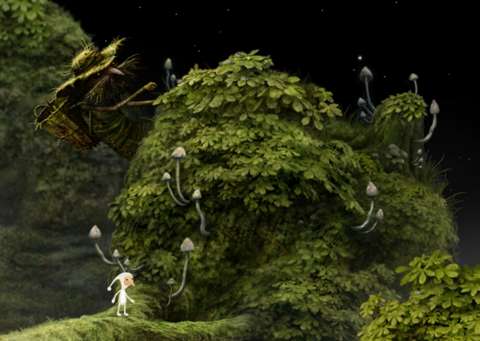
DIFFERENT PACING OF NARRATIVE:
Unlike the previous games, this one would not immediately present the excuse for the protagonist to go after the antagonist from the beginning of the playthrough. Rather, the earliest that the protagonist is informed about the antagonist is at the midpoint of the playthrough. This is when another character laments about its current state, which had been brought about by the antagonist.
If the player has not read the aforementioned storybook or has not been reminded of certain things that appeared in the storybook, the player is not likely to realize the context of why the protagonist is going after the antagonist.
THE CLARINET-LIKE RELIC:
The peculiar properties of the clarinet-like relic make themselves known early on. They are somehow capable of drawing out spirits, either spirits that are inhabiting inanimate objects or the spirits of living things that could not communicate with speech.
However, before the protagonist can call out spirits, the player has to watch the protagonist listen to some tune with the relic and then replay the tune with the relic. This can take a while, and is only entertaining for the first time.
For better or worse, the player character must do this every time that the player wants to observe the spirits’ messages again. This is an example of the issue of not being able to skip animations and cutscenes, which will be elaborated further later.
HAVE TO GO ELSEWHERE:
Prior to this game, the previous Amanita Design titles have puzzles that can be mostly completed within the same scene. There have been some games, such as Machinarium and Botanicula, that require the player to bring things to other places (especially Botanicula, because it was one of the main conceits of the story). Although these puzzles were not very complex, they were able to seize the player’s attention because the player does not need to have the player characters move elsewhere.
For better or worse, Samorost 3 is closer to other point and click adventure games than it is to its predecessors. There are more than a few puzzles that require the player character to go back and forth between places, just so that the player can examine things and test theories for solutions.
One example of this is a puzzle that involves three metered totems with controls that are in a room underneath them. Without having looked at the hint-book or other guides, the player would have to move back and forth from the surface area with the top portions of the totems to the underground chamber with their bottom portions. This is needed in order to figure out the puzzle gimmick of the totems.
PROTAGONIST IS MORE LIKE A PLAYER CHARACTER:
In the previous Samorost games, the protagonist is more like a bystander. He stands around, watching and waiting for the player to click and click until obstacles go away. This gave the impression that the actual player character is some kind of guardian angel or djinn that is helping the protagonist do things that he could not do.
In this game, the protagonist is more actively involved in puzzle-solving. In particular, he would be hauling things about and holding tools in his hands while using them. This makes him feel more like the player character of an adventure game, which is perhaps for the better – at least until the player has to have him repeat animations.
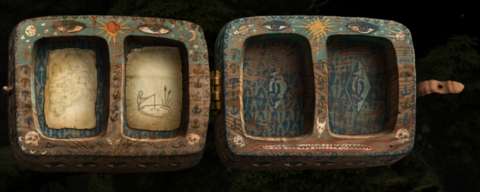
STILL A DJINN:
On the other hand, the player is still the protagonist’s unseen angel/djinn. There are things that the protagonist simply could not reach or interact with, at least not without putting himself at great risk. For example, the player will be holding the sprites of characters, be they small animals or plants, so that they can be transferred to somewhere that the protagonist cannot get to.
If the player is not handling them around like an omnipotent poltergeist, the player would be poking at things in the current scene to get them to do something in response. This is not unlike the previous games (and the other Amanita Design games).
These scenes become more common in the latter half of the playthrough, where there are much more bizarre things on-screen.
MEMORY PUZZLES:
Long-time followers of adventure games would notice that this game has many memory puzzles. Specifically, these puzzles require the player to remember patterns, codes or other kinds of mnemonics and apply them whenever the player see something familiar.
The example of the totems has been mentioned already. In addition to remembering the patterns that the totems’ spirits want, the player has to figure out how exactly the totems indicate which patterns are marked.
For another example, there are quite a number of “Simon Says” puzzles. These tend to involve certain luminous bugs that want their antennae twitched in specific ways.
For yet another example, there are some puzzles that require the player to remember certain tunes and replay them later. These can be tough, especially if the clue for the tune is played with something that has completely different pitch and bass than those for the device that the player has to play the tune with.
Perhaps the most common examples are the pictorial tales that the spirits tell. They show animated images that indicate what the player should seek or do.
SPACE TRAVEL:
In the previous Samorost titles, the player could only watch the protagonist fly his space-ship over to other islands, or watch some other characters fly their own ships about while the protagonist is hitching a ride. In this one, there is at least some semblance of travelling, thanks to the living ship that the protagonist and an engineer-like persona would craft.
However, the living ship is not without limits. It has limited range, due to its use of an air bladder. Therefore, it has to land on other things to refill its air supply. Conveniently, these other things – most of which resemble meteors – are orbiting around the islands. Therefore, the ship can detach off these smaller bodies to reach the islands.
Granted, there are not a lot of places to visit, because Samorost 3 is a short game. Still, the animations and mechanisms for space travel seem convincingly designed to accommodate the movement of the ship from just about anywhere it happened to be, i.e. the ship is not moving on invisible rails. In fact, the post-ending scenes would show that it is indeed the case.
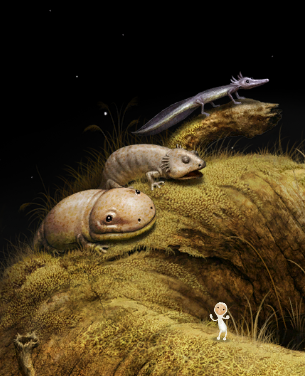
HINTBOOK:
In addition to the storybook, the user interface also includes a hint-book that shows the solution set-up for the current scene. The player also needs to do a puzzle before being able to open the hintbook and look at the diagrams that depict the solutions. This is not unlike the hint-book in Machinarium, though it is certainly faster than the mini-game in Machinarium.
Hand-drawn diagrams show the solutions. The details of the diagrams can vary a lot. Some have step-by-step instructions. Some others do not, and these simply point out whatever in the scene that happen to be part of the solution.
In particular, the player will want to identify the things in the scene that is associated with an achievement. For this purpose, they are linked with arrows to a symbol that resemble a constellation of suns.
ACHIEVEMENTS:
Most of the achievements are obtained from completing optional puzzles. These tend to be more difficult than the mandatory ones, such as requiring the memorization of a sequence of substantial length. However, some can be obtained from messing around, such as disturbing the bats that are residing in a cave. Some others can be obtained in the aftermath of having defeated the antagonist.
VISUAL DESIGNS:
The most notable visual improvement that this sequel has over its predecessors is a much more animated player character. The protagonist has very smooth animations, which he gleefully shows off. The player would see many frames in his running, dancing and climbing animations, among other things.
Like the other Amanita Design games, there are plenty of things that are bizarre and whimsical. Some are seen early on, such as the peculiar rock formations on the island that the protagonist lives on. The most whimsical scenes are those that involve the achievements. For example, there is one that happens early in the playthrough, in which the player gets the protagonist onto an elk-like creature that lives among the mountain peaks on the island.
The whimsical visuals also include examples of laziness. The most prominent of these is the clarinet-like instrument, which resembles a simple beige concave cone. Although Samorost and certain other people would play them like a clarinet, e.g. using their fingers to achieve different notes, there are no clear holes or buttons for the valves that should be in a clarinet.
CANNOT SKIP ANIMATIONS AND CUTSCENES:
Certain examples of animations that cannot be skipped have been described earlier. Indeed, not being able to skip cutscenes and animations is a perennial problem throughout the game. There does not appear to be any control input to do so. In fact, during the cutscenes and (mostly one-way) dialogues, on-screen controls are taken away from the player. The most that the player could do is bring up the menus.
However, there is a work-around involving those menus. It is possible to attempt a game-save during a cutscene. Reloading the game-save may place the player at the point past the cutscene. On the other hand, the player risks instability in the game.

SOUND DESIGNS:
There is no recognizable speech whatsoever in the game, but then, Amanita Design has always thought that gibberish-speak is a trademark of its games. Like the other games, the voice-overs rely on their intonations to convey the intended message. For example, pairs of grunts (often accompanied with head-shaking) indicate negative responses.
The most notable voice-over is that for the protagonist. In the previous Samorost titles, he sounded like an adult man trying to sound young, which is not always convincing. In this game, he does sound like he has been voiced by an actual boy.
Some sound effects are made using human voices; this can seem cheap, though it is part of the intended charm of the game. Fortunately, the sound designers have diversified their repertoire of skills since the previous games. For example, some of the noises that have been made using human voices have been strained through filters so that they sound less recognizable as having been uttered through a person’s mouth.
In its game development history, Amanita Design is at its most ardent in implementing music in the gameplay of this game. There are many puzzles with clues that are accompanied with musical cues. Indeed, there is at least one optional puzzle that has to be solved by recreating a tune.
That said, there are plenty of music tracks in this game, more so than in the previous games. Most of them match the mood of the current scene and will change according to the player’s progress in the playthrough.
CLUNKY SAVING/LOADING INTERFACE:
The player can make up to two-dozen game-saves. Each game-save is represented with a thumbnail image, each of which has been made for each scene. Although the image does show where the player is currently at, there is no other important information, like time stamps.
Moreover, the game has to use two different screens, one for loading game-saves and the other for making them. Both screens use the same list of thumbnails; the control inputs are merely swapped.
Furthermore, an existing game-save cannot be overwritten, at least not directly. Rather, the player has to delete the game-save, and then write a new one into the same slot. This is tedious, and would have been even more of a hassle if the playthrough had been any longer.
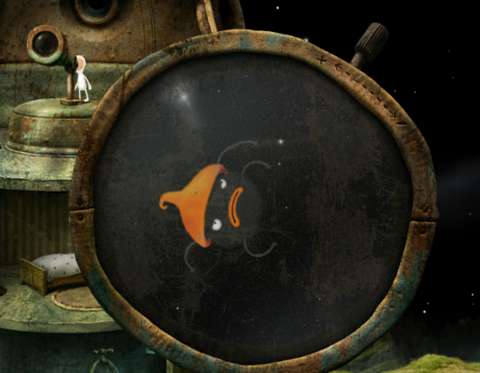
CONCLUSION:
Like the games before it, Samorost 3 is full of entertainingly bizarre scenes, all done without any utterance of legible dialogue or readable text. Perhaps more importantly, the protagonist is more of a player character than a mere spectator.
Yet, for all the things that Amanita Games consider to be amusing, it continues to fail at implementing designs that make adventure games less of a hassle to play. There are no means to skip travelling animations. There are no means to skip cutscenes. These omissions make the tropes of the puzzle designs all the more apparent.
Consequently, the game is at its best when the player knows exactly what to do and intends to record the experience of a “perfect” playthrough. For anyone else who is playing the game for the first time without a guide, trying different possible solutions for the puzzles can be tedious.
